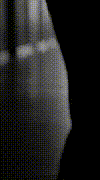Here's an article I found on the web; thought someone might be interested to read it.
Why can't you tickle yourself?
One way that is guaranteed to cheer up a tired, cross child or to reduce an adult to a simpering fit of giggles is a few light strokes on the sole of the foot or the armpit. Some people are more tickly than others, and ticklishness varies from situation to situation.
But one question has baffled minds for years: why can't you tickle yourself? Go on - try it. The sensation produced will never rival that of an external stimulus.
The sensation of tickle is perceived by the part of the brain called the somatosensory cortex (also called S1). Studies using functional magnetic resonance imaging, a technique which shows changes in brain activity in different situations according to cerebral blood flow, have shown increased S1 activity in response to an externally produced tactile stimulus. However, the same activity is not produced after an identical, self produced stimulus.
We need to turn our attention away from the cortical areas of the brain to the cerebellum, a structure attached to its base, to understand why this is the case. The cerebellum has a role in coordinating movement, and receives both sensory input from the body (via the spinal cord) and motor input from the higher cortical areas that command movement. In other words, one of its roles is the comparison of the expected response to a stimulus (relying on descending commands from the motor cortex of the brain) with the actual response (relying on sensory feedback from the receptors in the skin). If the two responses match, the cerebellum kicks in a mechanism to suppress the effects of the stimulation, and the end result is diminished activity in the somatosensory cortex, and with it diminished perception of the tickle. This cancellation of the sensory consequences of a motor command is the phenomenon known as reafference.
Of course, there are other factors involved. The predictability of the stimulus is important - if subjects are blindfolded they will report a greater tickle sensation. Sensory feedback from the limb doing the tickling also acts to reduce the feeling. There may also be social or sexual influences - for example, the sensation can be greater if tickled by someone of the opposite sex. Subjects report the greatest tickle sensation while their eyes are closed, because there is an absence of feedback, reafference, and predictability.
------------------------------------------------------------
I personally can tickle myself (I discovered this when I was very young 😀) - not everywhere mind you and the sensation is quite different. If anyone is curious about this feel free to ask! Can anyone else tickle themselves?
Ayesha
Why can't you tickle yourself?
One way that is guaranteed to cheer up a tired, cross child or to reduce an adult to a simpering fit of giggles is a few light strokes on the sole of the foot or the armpit. Some people are more tickly than others, and ticklishness varies from situation to situation.
But one question has baffled minds for years: why can't you tickle yourself? Go on - try it. The sensation produced will never rival that of an external stimulus.
The sensation of tickle is perceived by the part of the brain called the somatosensory cortex (also called S1). Studies using functional magnetic resonance imaging, a technique which shows changes in brain activity in different situations according to cerebral blood flow, have shown increased S1 activity in response to an externally produced tactile stimulus. However, the same activity is not produced after an identical, self produced stimulus.
We need to turn our attention away from the cortical areas of the brain to the cerebellum, a structure attached to its base, to understand why this is the case. The cerebellum has a role in coordinating movement, and receives both sensory input from the body (via the spinal cord) and motor input from the higher cortical areas that command movement. In other words, one of its roles is the comparison of the expected response to a stimulus (relying on descending commands from the motor cortex of the brain) with the actual response (relying on sensory feedback from the receptors in the skin). If the two responses match, the cerebellum kicks in a mechanism to suppress the effects of the stimulation, and the end result is diminished activity in the somatosensory cortex, and with it diminished perception of the tickle. This cancellation of the sensory consequences of a motor command is the phenomenon known as reafference.
Of course, there are other factors involved. The predictability of the stimulus is important - if subjects are blindfolded they will report a greater tickle sensation. Sensory feedback from the limb doing the tickling also acts to reduce the feeling. There may also be social or sexual influences - for example, the sensation can be greater if tickled by someone of the opposite sex. Subjects report the greatest tickle sensation while their eyes are closed, because there is an absence of feedback, reafference, and predictability.
------------------------------------------------------------
I personally can tickle myself (I discovered this when I was very young 😀) - not everywhere mind you and the sensation is quite different. If anyone is curious about this feel free to ask! Can anyone else tickle themselves?
Ayesha








